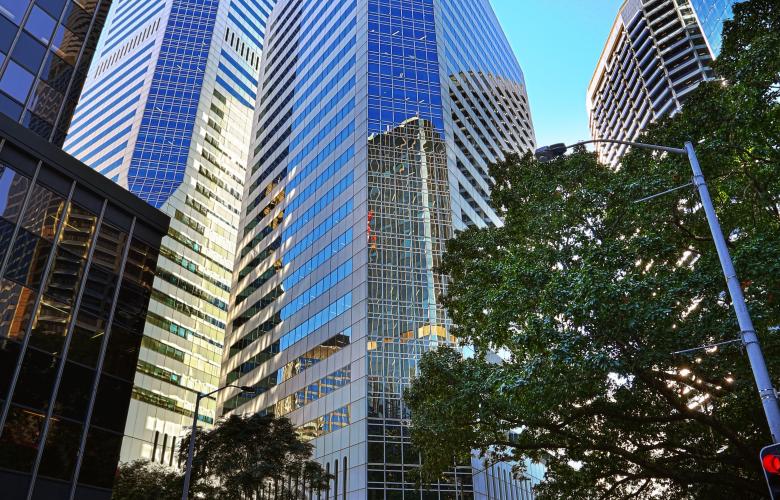Brisbane office tower in the heart of 'golden triangle' for sale
Contact
Brisbane office tower in the heart of 'golden triangle' for sale
Sale of A-Grade office building at 66 Eagle Street in the heart of Brisbane’s ‘golden triangle’ expected to attract global interest.
Designed by world renowned Japanese architect Kurokawa Kisho, 66 Eagle Street comprises almost 32,000 square metres and is home to esteemed tenants including QIC, McCullough Robertson along with State and Federal Government departments.
The tower, which sits on a prime 2,510 square metre three-frontage corner in Brisbane’s tightest office market, has recently undergone a nearly $10 million premium capital expenditure program which included the design and creation of a new lobby and café, an overhaul of the end-of-trip facility Bespoke and new bicycle storage.
The sale process will be driven by JLL’s Seb Turnbull, Luke Billiau and Paul Noonan along with Cushman & Wakefield’s Richard Butler, Josh Cullen and Mark Hansen, with the International Expression of Interest process closing on 24th October 2019 at 3pm.
At a glance:
- Super-prime office tower in the heart of Brisbane’s ‘golden triangle’ to be sold
- Building comprises almost 32,000 square metres of office space and sits on prime 2,510 square metre three-frontage corner
- Sale represents only the third 100 per cent interest sale in the central precinct in the last decade
The building has been designed and maintained to PCA A-Grade standard, with 23 levels of floor plates in excess of 1,400 square metres as well as parking for 211 cars over three basement levels.
The Australian Prime Property Fund Commercial owns 50 per cent of the asset.
JLL’s Seb Turnbull said that 66 Eagle Street will be only the third 100 per cent interest sale in the core ‘golden triangle’ precinct in the last decade.
“Given the scarcity of this offering in combination with improving market fundamentals we expect strong interest from both across the world and around the country,” he said.
Cushman and Wakefield’s Richard Butler said there had been a substantial uplift in foreign capital targeting Australian office assets in the past 12 months and that the Brisbane office market remains one of the most attractive destinations.
“As Brisbane CBD office leasing conditions continue to improve, offshore investor demand is set to increase particularly at this point in the global economic cycle, where quality and well located assets like 66 Eagle Street offer the potential for relatively stronger yields compared to other asset classes,” he said.
Mr Billiau, from JLL, said that Brisbane commercial office market incentives peaked in 2018 and continue to track down, driving effective rental growth in Brisbane.
“Relative to the last cycle, at the point the market had a similar vacancy level for A-Grade stock it experienced a substantial uplift in effective rental growth. This is our expectation and the outlook for a continued tightening will drive total returns in the Brisbane market,” he said.
“The resetting of market rents in Brisbane underpins the investment thesis that there is less downside risk relative to the southern markets of Sydney and Melbourne. Rents are 53 per cent off our peak in 2008, which provides incoming investors with the opportunity to drive value through income growth, rather than relying heavily on yield compression.”
Noonan said that 66 Eagle Street was perfectly positioned to capitalise on the $45.8bn of infrastructure investment in Queensland set to redefine the capital.
“66 Eagle Street sits at the epicentre of Brisbane’s infrastructure boom and is set to benefit from surrounding projects including the Waterfront Precinct, Cross River Rail and Queen’s Wharf,” he said.
“The most significant of these is the $3.6 billion Queen’s Wharf Casino and Entertainment Precinct which will entail the redevelopment of approximately 10 per cent of the CBD to create a stunning, integrated resort precinct just 500 metres from the property.”
Similar to this:
Off-market sale in Brisbane CBD the biggest settled strata transaction so far this year
Brisbane sets the trend for merging buildings
Brisbane shopping centre sold for $17.5 million to interstate investor







